Results 1,981 to 1,990 of 12089
Thread: Anandtech News
-
06-08-12, 03:30 AM #1981
Anandtech: TI Joins the Windows RT Demo Fray
Not one for being left out, TI had a demo of Windows RT running on its OMAP 4470 reference tablet. Microsoft instructed its partners not to show off anything but the start screen when allowing photography for Windows RT devices so the picture above is all we're able to provide you (despite showing much more in earlier coverage).
How well did OMAP 4 run Windows RT? At least as well as the rest of the ARM SoC makers, in other words: quite good. Scrolling was smooth, switching between apps was fast and everything just worked.
Microsoft still needs to tweak the Metro UI as some animations are still jittery at times but there's still a lot of time between now and the expected August - October release of Windows 8.
More...
-
06-08-12, 03:30 AM #1982
Anandtech: SandForce Demos 19nm Toshiba & 20nm IMFT NAND Flash
SandForce's controllers have fairly broad compatibility with NAND available on the market today. It shouldn't be a surprise that the first demo we saw of Toshiba's 19nm and Intel/Micron's 20nm NAND was at the SandForce/LSI suite in the Grand Hyatt in Taipei.
Even though 19nm/20nm 64Gbit devices aren't very different from their predecessors, they still require custom firmware support for many reasons including dealing with different program times. Intel and Micron have told us that they expect similar endurance from their 20nm NAND as we currently see with their 25nm offerings.
The demo we saw was a simple Iometer test on both platforms. SandForce built SF-2000 drives using NAND from Intel, Micron and Toshiba. The Intel part number hasn't changed much from the 25nm generation. The table below highlights the differences:
The last F actually indicates that we're looking at a 20nm part, while the 3 actually refers to generation which seems to have been incremented along with the process node identifier. We should see the first 19nm/20nm based SSDs this year, but keep in mind these aren't dramatically different architecturally from the 24/25nm parts on the market today.Intel MLC NAND Part Number Comparison 25nm 64Gbit 20nm 64Gbit Intel 29F64G08ACME2 29F64G08ACMF3
When we get to 128Gbit 20nm die from IMFT next year we will see some major changes including a faster interface (ONFi 3.x) and larger page sizes (16KB).
Gallery: SandForce Demos 19nm Toshiba & 20nm IMFT NAND Flash





More...
-
06-08-12, 04:00 AM #1983
Anandtech: Hands on With EVGA's GeForce GT 640
NVIDIA officially launched its first retail desktop GK107 part earlier this week as the GeForce GT 640. After getting a load of the mammoth GTX 680 Classified, EVGA's GeForce GT 640 looked downright adorable.
Gallery: Hands on With EVGA's GeForce GT 640



More...
-
06-08-12, 04:00 AM #1984
Anandtech: EVGA's GeForce GTX 680 Classified, Water Cooling Optional
As one of the most well known NVIDIA partners we were expecting a heavily overclocked, very custom take on the GeForce GTX 680. At Computex EVGA brought its GeForce GTX 680 Classified. The design requires a custom PCB to support some of EVGA's unique features including a 14-phase power design. There are two custom headers along the top of the card. One header allows you to get direct access to reading the card's voltages. The second header is for use with EVGA's EVBot tool that allows direct control over those same voltages outside of software. No word on default clocks for the Classified, although you can expect it to be EVGA's highest overclocked GTX 680.
There will also be a water block available for the Classified. The current prototype is pictured above, with more shots in the gallery below.
Gallery: EVGA's GeForce GTX 680 Classified, Water Cooling Optional





More...
-
06-08-12, 04:30 AM #1985
Anandtech: EVGA's UV Plus 39 USB 3.0 Display Adapter
Along with a host of video cards, EVGA also brought its latest UV Plus USB display adapter to Computex. Now with USB 3.0 support, the UV Plus 39 can drive both its HDMI and single-link DVI ports simultaneously at up to 1080p. The virtual GPU driver does rely on your host CPU for the heavy lifting just as previous versions have in the past. The move to USB 3.0 should improve performance although EVGA didn't have a demo setup to demonstrate exactly how much the higher bandwidth interface improved things.
Gallery: EVGA's UV Plus 39 USB 3.0 Display Adapter




More...
-
06-08-12, 05:30 AM #1986
Anandtech: Synaptics' Hinge-less Clickpad and More at Computex 2012
After snagging long time AMD/ATIer Godfrey Cheng, Synaptics is looking to significantly increase its public exposure. As a manufacturer of touch controllers and touch platforms in an increasingly touch driven world, Synaptics has a significant role to play in the devices we use and review.
I spoke with Synaptics at the show about the relatively poor state of current buttonless click pads that PC OEMs have been shipping for far too long. Synaptics claims that its reference designs can deliver great performance, however it's up to PC OEMs to actually implement all of the components in the design. In the constant quest for lower pricing while maintaining margins, PC OEMs have often sacrificed in areas such as display, keyboards and of course trackpads.
This is thankfully beginning to change. With a desire to move up in the market coupled with Microsoft's more stringent certification for Windows 8 touchpad solutions, it looks like things will get better over the next year. Some OEMs are even taking matters into their own hands. I met with ASUS at the show and was shown a version of the Zenbook with an ASUS developed touchpad driver.
Synaptics also gave me some hands on time with their Click EQ product. Buttonless trackpads are commonplace on many modern notebooks however they are usually the top hinged design, similar to what Apple uses in its MacBook Pro/Air lines. A single hinge along the top of the trackpad makes clicking near the bottom of the trackpad easier than clicking near the top (a difference in leverage). Synaptics Click EQ on the other hand lacks a single hinge, instead the entire surface of the clickpad moves up and down when you click it. In other words, it requires equal effort to click regardless of where you're pushing on the pad. Acer's Chromebook currently features a Click EQ pad, while Synaptics says other designs are forthcoming.
Finally, Synaptics is working closely with NFC vendors as the trackpad/clickpad is likely going to be where NFC enabled notebooks interface with NFC tags or other NFC devices. Intel actually had a demonstration at the show where an NFC enabled Medfield phone sent the currently active URL in the browser to an NFC enabled Ultrabook simply by bringing it near the trackpad of the notebook. The trick is making sure the trackpad doesn't cause any interference with the NFC and vice versa. Synaptics showed a demo where the trackpad was fully functional during an active transfer over NFC.
Needless to say there's a lot of work that goes into making these touch interfaces work properly. Given how important touch is today and how important non-traditional interfaces will be going forward, expect to see a lot of innovation on this front.
Gallery: Synaptics' Hinge-less Clickpad and More at Computex 2012


More...
-
06-08-12, 09:30 AM #1987
Anandtech: US-CERT Takes AMD To Task On Driver Security
In a bit of an odd move, the US Computer Emergency Readiness Team (US-CERT) has posted a vulnerability report and a blog post taking AMD to task over their drivers and the impact on system security. As the United States’ de-facto internet security agency – a public-private organization under the control of the DHS – US-CERT is both a front-line organization for developing responses to cybersecurity threats and on a more typical day is responsible for organizing and publishing reports and notices about computer system vulnerabilities. So while it’s common for US-CERT to publish information regarding specific vulnerabilities, it’s much less common for them to get involved with general security weaknesses.
So what has drawn US-CERT’s attention? It turns out that AMD’s drivers don’t properly behave with/support a vulnerability mitigation feature called Address Space Layout Randomization (ASLR). ASLR serves to make it harder for software vulnerabilities to be exploited by randomizing certain program structures in memory, so that the addresses of these structures cannot reliably be predicted and attacked. Although not undefeatable, ASLR can reduce a number of different types of attacks from a system-owning exploit into a program crash that keeps the system secure. In other words ASLR can’t fix the underlying vulnerabilities in programs, but it can help mitigate the problem so that a proper fix can be instituted.
Because of the chaotic nature of ASLR not every program (particularly legacy programs) can work with it, and for that reason since its introduction in Windows Vista in 2006 ASLR has been a per-program feature that is only enabled with applications that are flagged as being compatible. However because most applications can handle it just fine, systems requiring higher security can use the Enhanced Mitigation Experience Toolkit (EMET) to enable ASLR across the system, which forcibly activates ASLR for all programs.
It’s this last bit that has caught the US-CERT’s attention. As it stands AMD’s video drivers are not ASLR compatible. Turning on ASLR will cause AMD’s drivers to crash, making always-on ASLR unusable on systems using AMD’s drivers.
From a practical perspective this isn’t an issue that affects more than a handful of users. Unlike DEP it’s not something that can be turned on from within Windows, so even technical users like ourselves almost never have ASLR in always-on mode. However for governments and other high value institutions this means they’re forced to choose between AMD hardware and ASLR, which is not something they want to be worrying about. Furthermore it’s been the long-standing goal of computer security organizations to get OSes and programs to a state where ASLR can be enabled globally for every user, a very messy transition that is held back by programs and drivers that are still not ASLR compatible.
Drivers in turn are of particular concern here because of how they interact with the Windows kernel, with video drivers in particular having high access levels for performance purposes, a position that will only become more entrenched as GPUs continue to become more CPU-like and more important to even fundamental computing. All of this is compounded by the fact that AMD in has already been in the spotlight for security vulnerabilities as their drivers were found to have a security exploit in 2007.
Ultimately the US-CERT is looking to apply pressure to AMD to get them to finally make their drivers ASLR compatible, even going so far as to specifically testing and naming Intel and NVIDIA as having ASLR compatible drivers in the vulnerability note. Having an arm of the US Government breathing down your neck does tend to get results, doubleplus so since the US Government is also a massive IT buyer. In the meantime typical computer users have nothing to be concerned about – and this is the important part for most of us – but it’s unfortunate that AMD has let themselves end up in this situation in the first place.
Source: Slashdot
More...
-
06-08-12, 11:00 PM #1988
Anandtech: Computex 2012: Lian Li Want To Sell You A Train, Or A Case with 26 3.5” HD
Visiting the Lian Li booth is always interesting. Last year we saw the TU-200 mini-ITX case aimed at taking a gaming machine with you on the move. This year, we get trains.
The PC-CK101 is a limited run product which looks like a train but will fit inside a mini-ITX motherboard with a couple of SSDs and appropriate power. On the case are a couple of USB 3.0 ports, and there is even room for a slim optical drive behind the cow catcher. The model on display was accompanied with a version of the case that had been outfitted with an engine and had fully moving parts along a track.
Also on the Lian Li booth we were introduced to the PC-D8000. A double width and tall case designed to fit HTPX motherboards as well as twenty-six 3.5 inch hard drives (6 of them in hotswappable bays).
This case looks like it would be great for organising a 4 dual radiator water cooling setup (the top has panels which can be switched with a dual 120mm fan slots), with plenty of space for organisation. Or, as I suggested, a modder may adjust the case to fit two motherboards and two systems – one system for low powered usage (word processing, email, internet), and a second system for gaming.
Also on display was the PC-V650, a mATX version of the PC-Q09B, and the PC-V750WX, a normal height E-ATX case. LianLi also showed me the PC-X2000FN, a very tall case which is only slightly wider than a motherboard, with space above and below for hard drives.
Mini-ITX cases are also the order of the day, with LianLi having their vertical power supplied PC-Q02 and PC-Q03.
Gallery: Computex 2012: Lian Li Want To Sell You A Train, Or A Case with 26 3.5” HDD Slots





More...
-
06-09-12, 12:00 PM #1989
Anandtech: Acer's Iconia W700 Ivy Bridge Windows 8 Tablet: The Start of Something Big
My first meeting of Computex wasn't a meeting at all, rather it was Acer's press conference a day before the show officially started. In its press conference, Acer introduced a top to bottom lineup of touch enabled Windows 8 devices.
Among the list were two particularly interesting tablets: the Iconia W510 and W700. The former is an Atom (Clovertrail) based tablet with Transformer-style keyboard dock, while the latter is a full fledged Ivy Bridge based tablet. On my last day in Taipei I managed to secure some extended hands on time with the W700. I'm always asked what I was most impressed by at any trade show, and I'd have to say for this Computex it was definitely Acer's W700. It's not just a good device, but it's also the start of something very big.
Read on for our hands on impressions and analysis.
More...
-
06-11-12, 02:00 AM #1990
Anandtech: ECS Booth: Components in Gold, AIOs and an Ultrabook?!
Along withinterviewing ECS VP David Chien, AnandTech was invited to browse around the ECS booth. With ECS’ main market being motherboards, the focus was ultimately on new technologies surrounding the ECS branding.We have had a brief look at the Golden Series motherboards before in our Z77 preview and have a product in for review. ECS clarified their positioning with the Golden Series branding – in order to provide a higher-end product above their Black series that is aesthetically pleasing, especially to those who want to design gold colored systems and case modifications. There is apparently demand in various markets for this sort of product.
Nonstop Testing and Super Alloy Chokes
As with any other motherboard manufacturer, finding different ways to advertise their products is vital, preferably through innovative technology. A few manufacturers at Computex this year are advertising improved power delivery mechanisms – ECS are no different in this regard, with their Super Alloy chokes.
As you can expect, ECS were unwilling to explain how exactly their Super Alloy chokes work, but advertise that they offer 1.5x longevity, low electromagnetic interference, and up to 30% current delivery. In reality, 99% of users will not ever see a difference in operation, however I am informed that demand is there from various sources to increase the longevity of the power delivery.
Also in ECS’ arsenal is their Nonstop testing (or as they put it, Nonstop Technology). In a similar vein to MSI’s Military Class components, ECS are willing to put each of their products through an enhanced stability test – 72 hours at 50 degrees Celsius whilst under full load. Memory manufacturers test a lot in this area to eliminate the weaker modules that might initially fail after light loading, but now that concept is being applied to motherboards. The driving force for this testing clearly comes from industry, which is a major consumer of ECS products.
Golden GTX 680
To compliment the golden series motherboards, ECS are also producing a Golden Series GTX 680. ECS have been selling NVIDIA graphics cards for several years now (I have had two of the 580s as part of my test bed for a while), and the modification of their high end card to Golden Series is designed to be paired with the Golden Series motherboards.

A75 vs A85 chipset naming
On of the main features of Computex has been the long list of FM2 motherboards that will be available when Trinity desktop processors are released. The confusion for users will come in the fact that the FM2 socket will either come with the A75 chipset or the A85X chipset. FM2 Trinity processors will be incompatible with FM1 Llano sockets, but FM1 sockets are also paired with the A75 chipset. So the naming scheme with ‘A75’ will no longer indicate which socket of motherboard. Potential confusion ensues.
Every manufacturer has to find a way around this issue, and ECS are no different. With their products, all FM2 motherboards will be at least called ‘F2’. All A75 FM2 products will have the name ‘A75F2’, and all A85X FM2 products will be called ‘A85F2’.
On the ECS wall for FM2, we were shown the A75F2-A2 and the A75F2-M2, full sized ATX and micro ATX versions of their ‘A2’ product, aimed at the low end Trinity. Also on show was the A85F2-A Deluxe, part of their Black Series branding with the extra SATA ports that A85X provides.
Z77H2-A5X Thunderbolt board
Almost all the motherboard companies at Computex are announcing Thunderbolt boards – ECS are no exception. To market they will be bringing a single SKU, the Z77H2-A5X Black Deluxe. Within the naming scheme at ECS, A5 represents their high end SKU coupled with Black Series branding, one below the new Golden Series.
G24 Cupid
As 70% of ECS’ motherboard business is OEM selling, part of the other side of the business is being an ODM for a variety of other products (i.e. other companies buy their products and rebrand them as their own). Last year ECS had several AIOs on display, and this time I was shown their multi-touch G24 Cupid. They seemed very proud of it.
Using the Thin Mini-ITX form factor, the G24 supports a slim optical drive alongside a 3.5” or two 2.5” hard drives. The display is a 23.6” touch-screen TN panel, with a 16:9 display at 1080p. The branding behind the G24 to OEMs is that it can be highly and easily configurable, with a power supply up to 180W. The only thing missing from the display is a USB 3.0 panel, should an OEM decide to go with a USB 3.0 capable chipset – this is perhaps for a future release.
Ultrabook
With second generation ultrabooks on the wagon, and other traditional motherboard manufacturers entering the market, ECS have decided to enter the market as an ODM. Their ultrabook is still in the early stages of design, and for various reasons was only on display to selected media.
ECS have attempted to conform to Ultrabook specifications at their maximum limit, unlike the more MacBook Air type tapered designs seen elsewhere. Due to the stage of design ECS are still in, specifications are unknown, although from the design we have an Ethernet port (I am told GbE), USB 3.0, full-sized HDMI, SD card reader, and a slim optical drive.
As the product is purely for business to business sales, we won’t ever see this model being sold as ECS. We are told that there is interest in Turkish and Russian markets for the device.
Gallery: ECS Booth: Components in Gold, AIOs and an Ultrabook?!



More...
Thread Information
Users Browsing this Thread
There are currently 39 users browsing this thread. (0 members and 39 guests)




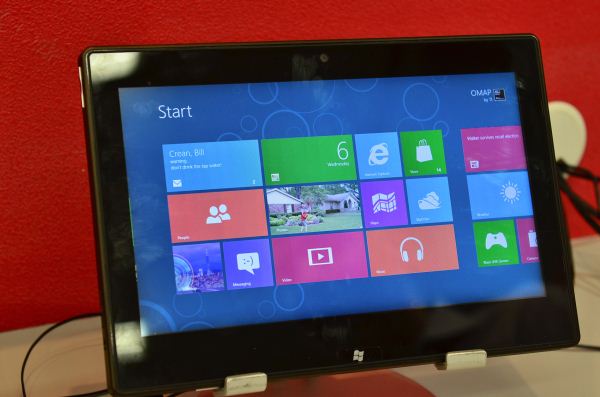

 Quote
Quote
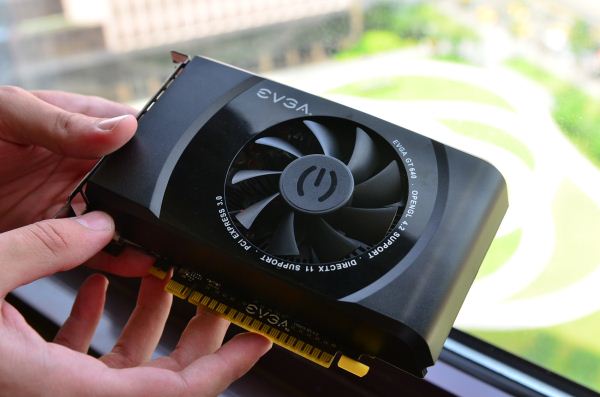
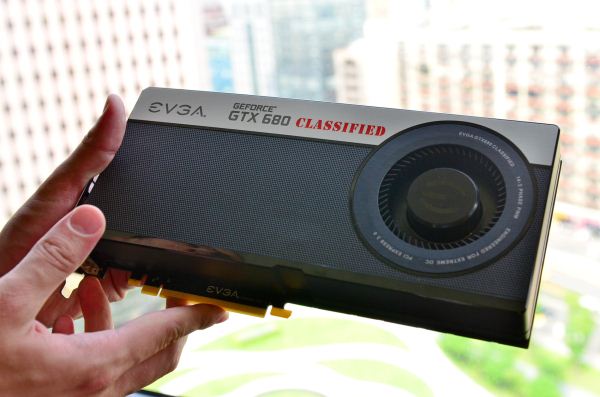


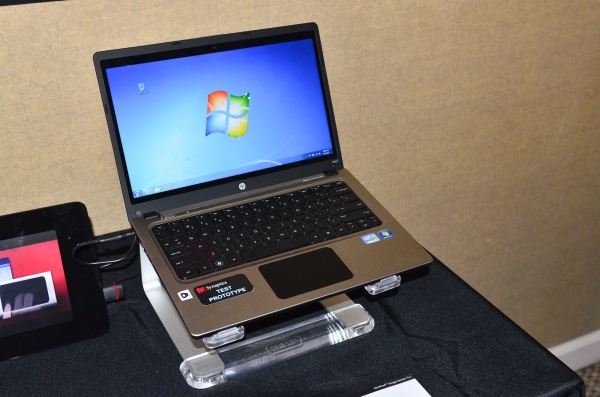
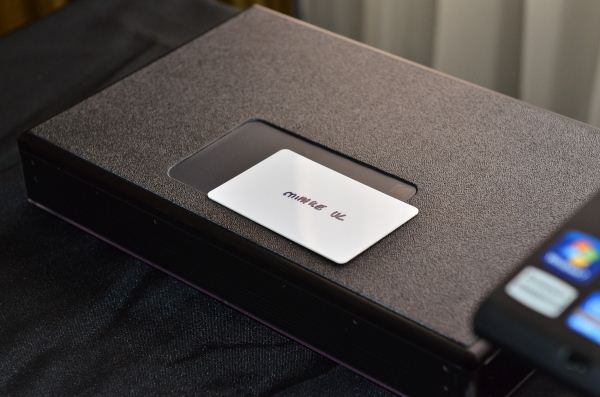





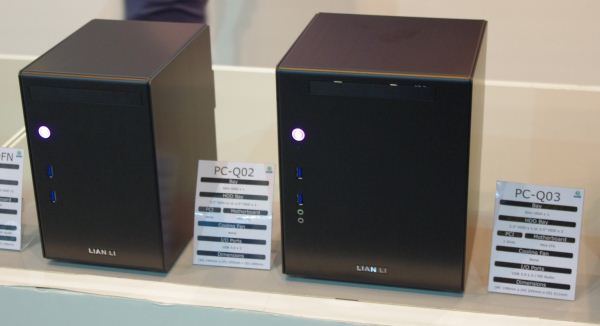
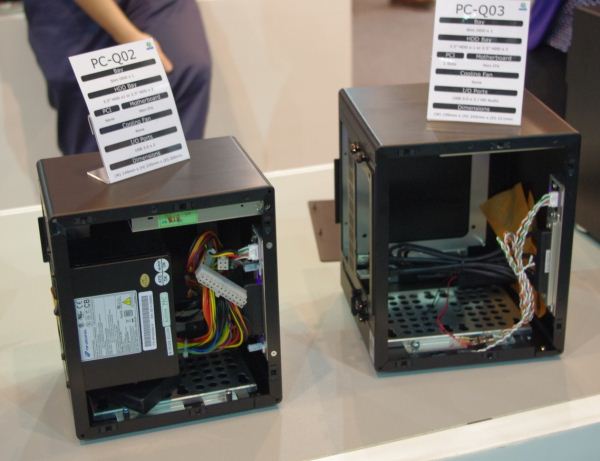
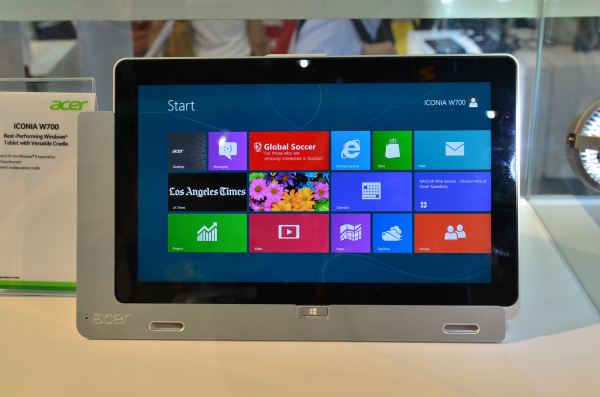
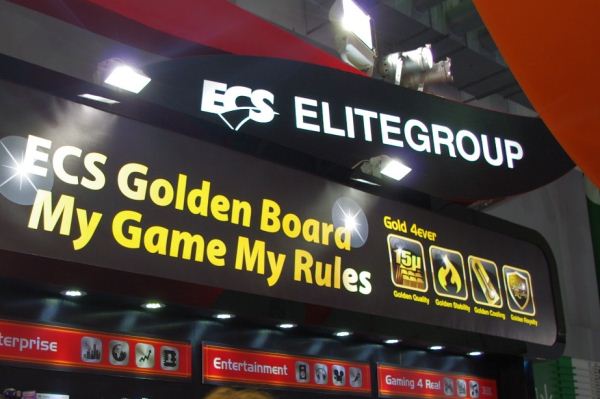
























Bookmarks